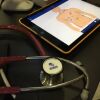Updated March 4, 2016
Cameras in EMS are coming; when, how and why are the bigger questions. Cameras have serious pros and cons. This double-edged sword is honed razor-sharp, so we need to understand and discuss the larger issues.
Here are the three major types of cameras and what they are used for in EMS.
1. Ambulance cameras
Vehicle cameras or driving cameras are mounted either inside or outside the ambulance to record traffic interactions. They are mainly for post-mortem dissection of accidents. They will protect you if you are not at fault in the collision, but let’s be honest — they are mainly used to protect your agency or employer.
The recordings will mitigate the liability of your department by proving whether the ambulance operator or the other driver was at fault. If you are found to be at fault, you will likely be fired for violating company policy.
My hope is that vehicle cameras may lead to safer driving practices. Some of my drivers over the years scared the pants off me, and maybe they would slow down and be more careful if they knew their driving was being recorded.
Police departments have used vehicle cameras, or “dash cams,” for years. Some good examples are from Digital Ally, Pro-Vision, and Martel Electronics to name just a few.
2. Personal or body cameras for EMS
Personal cameras or “body cams” are worn on the body, and they record your interactions with people or patients inside and outside the ambulance. They come in three basic types.
The body camera is worn either as an integrated lens and recorder, or less visibly as a small camera lens and belt-mounted recorder. The price of this type of camera has fallen dramatically; many models are actually very inexpensive. Examples include the Axon Body, FirstVu, Wolfcom Vision and Motorola Si Series.
The helmet camera is popular in fire departments, and as the name suggests, it’s worn on your helmet. You can even get a personal camera built into sunglasses. Some examples can be found here.
A newer type is the headset camera. These show unique promise because some can stream video in real time to the hospital base station.
Most personal cameras record on a solid-state drive or SD card. How these digital files are stored and shared seems a formidable challenge in EMS. HIPAA compliance issues make managing these recordings no small undertaking. They are mainly of use for dissecting an event after it has occurred.
As with CPR training, late feedback is far less effective than real-time feedback. Therefore I see them of limited potential value. The cameras that will have the most impact are those that help our receiving physician in the ER see what we see in the field.
3. Clinical cameras
This last type I term the clinical cameras. They are either mounted inside the patient compartment or as part of a mobile telemedicine solution. Since all three major telemedicine companies have robust HIPAA compliance protections, adoption won’t be as fraught with as many legal issues.
Clinical cameras may become invaluable. A picture does say a thousand words; it goes far beyond a verbal description alone. I sometimes view our verbal-based communication as pretty primitive since it has not changed much in over 30 years.
For instance, in 1978 I would talk to the hospital and send them an ECG. Today we can add a few leads, but our capabilities are largely unchanged. I hope we can soon stop talking through our assessment and start talking more about what we need to do to help.
When cameras would help EMS
Years ago I was in a situation when a camera could have saved me a few tense hours. A patient brought charges against me for taking indecent liberties during a transport.
When all involved parties examined my run report, they discovered the patient was morbidly obese and the time from scene to hospital was four minutes. I had done a decent job with my narrative and documented not only her combative behavior but also my struggle to get a good BP en route.
Everybody figured it would have been pretty unlikely I could have done anything in the remaining minute without cutting her clothes off, which I hadn’t, so it was quickly dropped. It was still stressful, and doubtless that stress could have been avoided with a digital recording.
Nevertheless, working in EMS is a tough job, and I’m not entirely convinced it will be made any easier with Big Brother watching over our shoulders. But if we focus on cameras that provide us new ways to make our communications more effective, we can realize benefits. I’m less sanguine about the other types.
What do you think? Would you be comfortable having your patient care watched and recorded?












